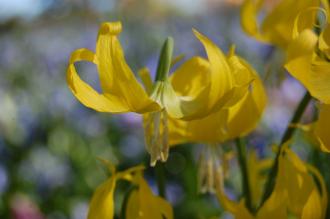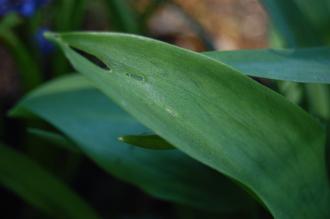
Erythronium grandiflorum (16/03/2014, Kew Gardens, London)
Position: Partial shade
Flowering period: Spring
Soil: Moist, well drained
Eventual Height: 30cm
Eventual Spread: 25cm
Hardiness: 4b, 5a, 5b, 6a, 6b, 7a, 7b, 8a, 8b, 9a, 9b
Family: Liliaceae
Erythronium grandiflorum is a deciduous herbaceous, bulbous perennial with a clump forming habit. Its mid green leaves appear in pairs, are lanceolate with entire margins, up to 20cm long and 6cm broad. Its yellow scented flowers are Lilly like, up to 35mm across and appear in groups of up to five on long, naked stalks. Its roots emerge from an oval shaped bulb which is up to 5cm across.

Erythronium grandiflorum Flower (16/03/2014, Kew Gardens, London)
Erythronium grandiflorum, commonly known as the Yellow Avalanche Lily or Glacier Lily, is native to west North America. In its native habitat it grows in sualpine meadows and woodland clearings and flowers as the snow melts.
The etymological root of the binomial name Erythronium is derived from the Greek erythros meaning ‘red’, as to what the red refers to in this species we are unclear. Grandiflorum is from the Latin grandis meaning ‘large’ and
As Erythronium grandiflorum is rarely cultivated as it is difficult to grow outside of its preferred habitat. When available landscape architect may find useful as a low growing herbaceous perennial, as part of a mixed herbaceous border.

Erythronium grandiflorum Leaf (16/03/2014, Kew Gardens, London)
Ecologically, Erythronium grandiflorum flowers are attractive to pollinating insects. In its native habitat the bulbs of this plant are eaten by bears, and other mammals.
Erythronium grandiflorum prefers moist, humus rich fertile, well-drained soils. It tolerates most pH of soil. It dislikes dry soils.
Erythronium grandiflorum requires little maintenance. Large clumps may be divided after flowering.

